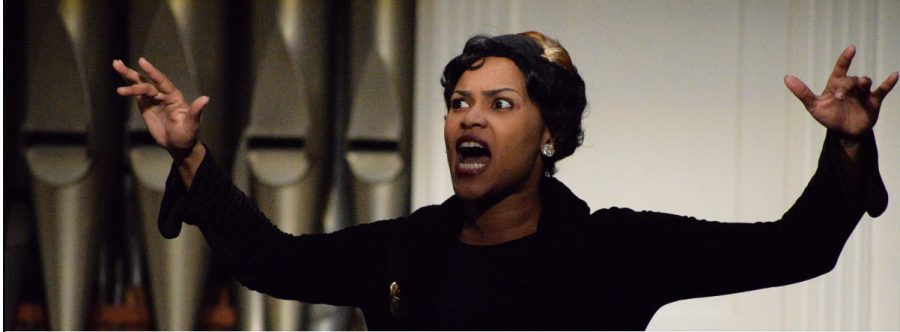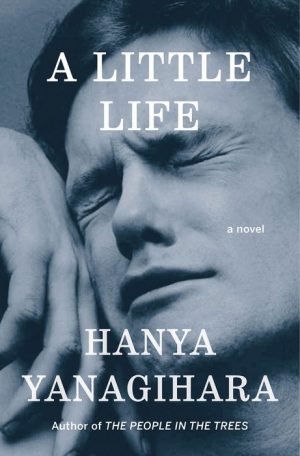“Ain’t I a Woman”: Where Is The Bitterness?
February 20, 2017
The history of the black woman is an aching one. Often used and abused, fetishized and exploited, Malcolm X translated the black woman’s experience into words: “the most neglected person in America is the black woman.”
Opening the second week of Black History Month, Stetson University’s Artist and Lectures Series brought “Ain’t I a Woman!” to Lee Chapel. The Core Ensemble performed on Feb. 7, promising that on this night the black woman would not be neglected.
The narratives of author Zora Neale Huston, painter Clementine Hunter, and voting rights activist Fannie Lou Hamer were threaded together by spirit of activist Sojourner Truth’s words that were delivered at the Ohio Women’s Rights Convention in 1851: “That man over there says that women need to be helped. Nobody ever helps me, and ain’t I a woman?”
At its close, the audience rose in standing ovation and smiled wide. But when the music was over and I walked home, there was a bit of dissatisfaction gnawing at my heart. I couldn’t place it. It wasn’t until I was in my bed and the rain started again when I realized what was missing from the performance: where was the bitterness?

The performance was ushered by the jazz music of Juilliard strings, Harvard keys, and a PhD. xylophone player. The actress, as Zora, clad in black velvet, greeted the audience like familiar friends, smiling as she said, “I know you haven’t seen me in a while.” She spoke of Langston Hughes and betrayal, but despite her hard life she still believed in the “magic created father sky and mother earth.”
Clementine begrudgingly let us enter her parlor while she painted art that she wasn’t sure why anybody liked. “I can’t give these away for free,” she joked. Fannie was resilient to exercise her right to vote when she said, “We gon’ get ours,” and I believed her.
The performances captured a lightness in their stories, a ceaseless optimism that seemed to prevail no matter what. These women, at least in this production, broke their literal and metaphorical chains with one fell swoop and flourished—but that isn’t quite right, now is it?
These black women faced poverty, rape, crushed dreams, and the overwhelming expectations of men resting on their shoulders. Their grace was not effortless. Their grace was earned through blood and rage and fear. They fought back salty tears and built up walls of resentment, they were bitter and angry—yes, angry. The caricature of the black woman we fear. Angry and vengeful. We fear that caricature because she is ferocious and wild.
Zora did not give a sigh of resignation when Langston sought out to ruin her. She clawed the concrete walls of the patriarchy—and died broke, but maybe not broken.
Clementine’s “pretty” paintings of plantation life were the only remains of that childhood naivety that she was forced out of too quickly.
Fannie’s hope, her conviction, was not unassailable. It was lost and she had to buy it back from the devil with a piece of her soul.
I will not be satisfied with sugar water alone. The performance showed only the optimism, the grace. But that wasn’t their lives. The sour bitter taste of lemon is what makes their lives worth tasting, and I longed for that acidity throughout the performance.
Black women are women of the sun and earth, but have had to claw their way out of dirt to reach that sunlight and grow tall. There is a darkness to their histories, like the melanin concentrated in their skin; one that cannot be glossed over with unwarranted optimism.
We needed to be taken through a journey, not placated. There is no room to spare pain or mince words this black history month. I refuse to accept a pretty poem left incomplete without the pain that their poetry was born from. On the stage, we saw portraits of grace and God and good—but just like the paintings Clementine made, those things are not given for free. They cost something. It cost Zora her fame. Clementine her spirit. Fannie her body.
The powers of hindsight has allowed us to label these black women as inspirational without understanding the volatile pain and diminished self-worth that paved their paths.
Shayla Simmons, the actress, recited her lines like music, Hugh Hinton, pianist, played with the kind of freedom people pray for, Ju-Young, the cellist, spellbound the audience with sense of rhythm, Michael Parola, the percussionist, effortlessly transformed the childlike xylophone into “grown-folk’s” music. The concept of highlighting black woman–who were erased under the shadow of big-named black men–as the civil rights martyrs they, too, were, was something that I valued more than the performance of my favorite John Coltrane song.
All I needed to see that night was the earthy bitterness of each black woman’s reality, like a cup of strong coffee to wake up this sleeping world. That, in the end, is what “Ain’t I a Woman” lacked. The bitter taste of these black women’s realities, not a sugar-coated fantasy.







